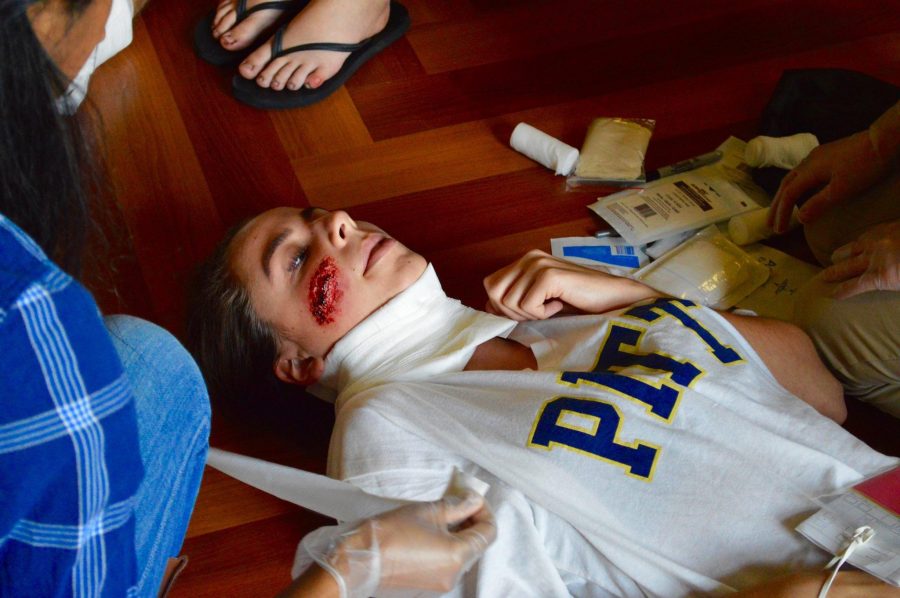After she said the building had collapsed, Lily Roth shouted through a microphone Sunday in the William Pitt Union, directing other students to search for dead or injured people.
“Guys, this person is freaking out,” Roth said. “I think this one might be dead. We have patients who haven’t been helped.”
As co-vice president of Pitt Student Emergency Medical Services, Roth rattled off commands to those acting as injured and first responders-in-training, attempting to organize the chaos she had helped plan for the club’s first mass casualty incident drill at Pitt.
At noon in the Assembly Room of the Union, Pitt SEMS organized the free event for Pitt and Carnegie Mellon students, most of whom were EMTs or training to be EMTs, to teach the students how to follow the chain of command during a mass emergency and how to treat victims efficiently. Fifty-one mock patients and 52 responders signed up to practice saving lives on the mass scale.
Though building collapses are rare in Pittsburgh, other large-scale emergencies, like mass shootings, have made headlines recently. In an effort to qualify Pitt as an EMS Ready Campus — a campus that has EMTs and EMTs-in-training prepared for any type of emergency — Pitt SEMS hosted the drill.
The National Collegiate Emergency Medical Services Foundation awards the Ready Campus designation each summer based on proficiency in warning the public of the emergency, having a properly trained staff and communicating with emergency leaders, among other qualifications.
Mock patients, some covered in red paint meant to look like fake wounds, sat and laid amid piles of old cardboard boxes that acted as rubble. Patients groaned loudly throughout the Assembly Room, crying to responders of lacerations, burns and asthma attacks. One patient lay unresponsive in the middle of the room, with a black tag around his wrist that signified his mock death.
Alexandra Savkova, the president of Pitt SEMS, said the drill educated both mock responders and patients on how to behave if they ever find themselves in some sort of large-scale disaster, believing it’s best to be prepared for anything.
“I’ve been a patient in a bunch of mass casualty incident drills in Philly and I learned a ton that I’m bringing into this,” Savkova, a senior majoring in emergency medicine, said. “This will give students an idea of what to expect in a mass casualty incident.”
Participants in the drill used the S.T.A.R.T. — Simple Treatment and Rapid Transportation — emergency response system, which emphasizes initial treatment of only immediately life-threatening wounds and encourages responders to move their patients to hospitals as quickly as possible.
Mark Pinchalk, one of the advisors for Pitt SEMS and the patient care coordinator for the City of Pittsburgh EMS, said S.T.A.R.T. is useful because it is so simple.
“No triage system is perfect. Unless you drill your people with them regularly, they’re hard to put in place when you get a real call,” Pinchalk said. “You need to keep stuff simple, that’s why I like the S.T.A.R.T. system.”
Along with simplicity, Pinchalk said the first responders need to establish a command structure as soon as they arrive on the scene of a mass casualty incident. For Sunday’s drill, Savkova, as president of Pitt SEMS, took over as incident commander over all of the participants.
Though some participants played more direct roles in triage and treatment, Roth said both patients and responders in the drill learned valuable information about emergency response.
“We learn not only by doing, but from watching other people do,” Roth said.
The patient learned about different injury patterns, such as how to stabilize pelvic injuries to prevent blood loss and how to stop arterial bleeds, as they had to learn how to act in accordance with their mock injury. Though the injuries were fake, the students wore disposable gloves, used gauze and tourniquets to stop bleeding and placed victims with broken bones on body boards.
Savkova said through Pitt SEMS, Pitt has become a HeartSafe campus, meaning those in the club are certified to notify others on campus when there is an emergency and train others in basic CPR. Though this year’s drill was the first, Pitt SEMS plans to make it an annual event.
In total, the drill cost the club between $200 and $300 for supplies, such as baby wipes for general sanitation, pens to sign in participants and tape to mark the floor with the boundaries of the disaster zone. Pitt SEMS raised the money through CPR classes and T-shirt sales, and obtained the remaining supplies, such as cervical collars and tourniquets, through donations. Paramedics, UPMC doctors and Pitt Police Officers also donated their time to the drill, where they instructed the responders on appropriate treatments specific to a mass casualty incident.
Although the event didn’t require any previous medical experience to participate, many of the responders were EMTs or paramedics. Responders, wearing navy blue shirts and carrying black triage bags, fanned out among the patients, assessing their conditions, stabilizing those with broken bones and working to stop bleeding as best they could.
“We achieved our objective that we wanted to achieve, which is basically just to show that there is an organized structure to a mass casualty incident,” Savkova said.
Though Pitt’s campus has been free from mass emergencies, Roth said these drills will train Pitt students to always be prepared.
“Being on a college campus, there’s potential for this stuff to happen,” Roth said. “It’s important to be aware.”



